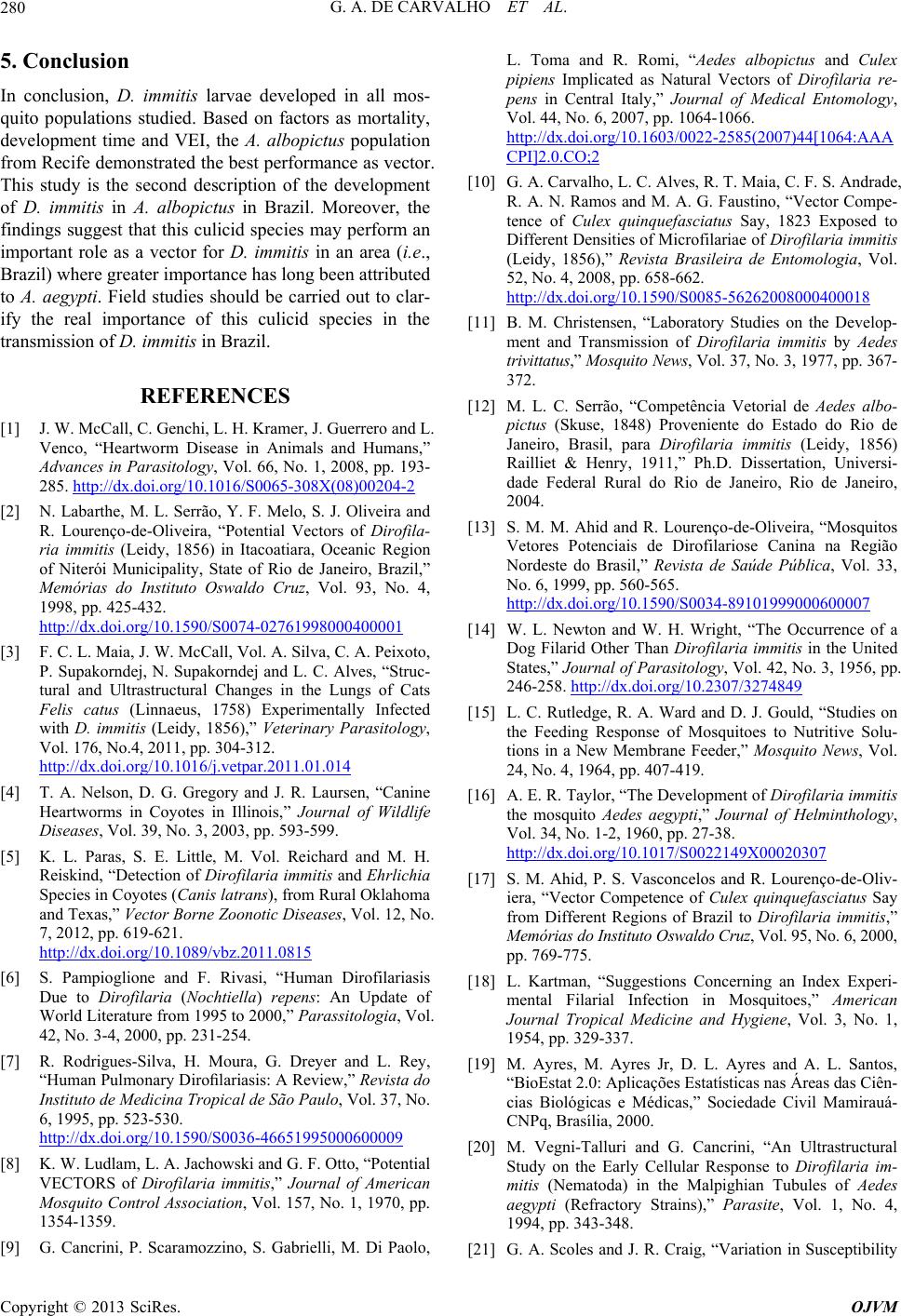
G. A. DE CARVALHO ET AL.
280
5. Conclusion
In conclusion, D. immitis larvae developed in all mos-
quito populations studied. Based on factors as mortality,
development time and VEI, the A. albopictus population
from Recife demonstrated the best performance as vector.
This study is the second description of the development
of D. immitis in A. albopictus in Brazil. Moreover, the
findings suggest that this culicid species may perform an
important role as a vector for D. immitis in an area (i.e.,
Brazil) where greater importance has long been attributed
to A. aegypti. Field studies should be carried out to clar-
ify the real importance of this culicid species in the
transmission of D. immitis in Brazil.
REFERENCES
[1] J. W. McCall, C. Genchi, L. H. Kramer, J. Guerrero and L.
Venco, “Heartworm Disease in Animals and Humans,”
Advances in Parasitology, Vol. 66, No. 1, 2008, pp. 193-
285. http://dx.doi.org/10.1016/S0065-308X(08)00204-2
[2] N. Labarthe, M. L. Serrão, Y. F. Melo, S. J. Oliveira and
R. Lourenço-de-Oliveira, “Potential Vectors of Dirofila-
ria immitis (Leidy, 1856) in Itacoatiara, Oceanic Region
of Niterói Municipality, State of Rio de Janeiro, Brazil,”
Memórias do Instituto Oswaldo Cruz, Vol. 93, No. 4,
1998, pp. 425-432.
http://dx.doi.org/10.1590/S0074-02761998000400001
[3] F. C. L. Maia, J. W. McCall, Vol. A. Silva, C. A. Peixoto,
P. Supakorndej, N. Supakorndej and L. C. Alves, “Struc-
tural and Ultrastructural Changes in the Lungs of Cats
Felis catus (Linnaeus, 1758) Experimentally Infected
with D. immitis (Leidy, 1856),” Veterinary Parasitology,
Vol. 176, No.4, 2011, pp. 304-312.
http://dx.doi.org/10.1016/j.vetpar.2011.01.014
[4] T. A. Nelson, D. G. Gregory and J. R. Laursen, “Canine
Heartworms in Coyotes in Illinois,” Journal of Wildlife
Diseases, Vol. 39, No. 3, 2003, pp. 593-599.
[5] K. L. Paras, S. E. Little, M. Vol. Reichard and M. H.
Reiskind, “Detection of Dirofilaria immitis and Ehrlichia
Species in Coyotes (Canis latrans), from Rural Oklahoma
and Texas,” Vector Borne Zoonotic Diseases, Vol. 12, No.
7, 2012, pp. 619-621.
http://dx.doi.org/10.1089/vbz.2011.0815
[6] S. Pampioglione and F. Rivasi, “Human Dirofilariasis
Due to Dirofilaria (Nochtiella) repens: An Update of
World Literature from 1995 to 2000,” Parassitologia, Vol.
42, No. 3-4, 2000, pp. 231-254.
[7] R. Rodrigues-Silva, H. Moura, G. Dreyer and L. Rey,
“Human Pulmonary Dirofilariasis: A Review,” Revista do
Instituto de Medicina Tropical de São Paulo, Vol. 37, No.
6, 1995, pp. 523-530.
http://dx.doi.org/10.1590/S0036-46651995000600009
[8] K. W. Ludlam, L. A. Jachowski and G. F. Otto, “Potential
VECTORS of Dirofilaria immitis,” Journal of American
Mosquito Control Association, Vol. 157, No. 1, 1970, pp.
1354-1359.
[9] G. Cancrini, P. Scaramozzino, S. Gabrielli, M. Di Paolo,
L. Toma and R. Romi, “Aedes albopictus and Culex
pipiens Implicated as Natural Vectors of Dirofilaria re-
pens in Central Italy,” Journal of Medical Entomology,
Vol. 44, No. 6, 2007, pp. 1064-1066.
http://dx.doi.org/10.1603/0022-2585(2007)44[1064:AAA
CPI]2.0.CO;2
[10] G. A. Carvalho, L. C. Alves, R. T. Maia, C. F. S. Andrade,
R. A. N. Ramos and M. A. G. Faustino, “Vector Compe-
tence of Culex quinquefasciatus Say, 1823 Exposed to
Different Densities of Microfilariae of Dirofilaria immitis
(Leidy, 1856),” Revista Brasileira de Entomologia, Vol.
52, No. 4, 2008, pp. 658-662.
http://dx.doi.org/10.1590/S0085-56262008000400018
[11] B. M. Christensen, “Laboratory Studies on the Develop-
ment and Transmission of Dirofilaria immitis by Aedes
trivittatus,” Mosquito News, Vol. 37, No. 3, 1977, pp. 36 7-
372.
[12] M. L. C. Serrão, “Competência Vetorial de Aedes albo-
pictus (Skuse, 1848) Proveniente do Estado do Rio de
Janeiro, Brasil, para Dirofilaria immitis (Leidy, 1856)
Railliet & Henry, 1911,” Ph.D. Dissertation, Universi-
dade Federal Rural do Rio de Janeiro, Rio de Janeiro,
2004.
[13] S. M. M. Ahid and R. Lourenço-de-Oliveira, “Mosquitos
Vetores Potenciais de Dirofilariose Canina na Região
Nordeste do Brasil,” Revista de Saúde Pública, Vol. 33,
No. 6, 1999, pp. 560-565.
http://dx.doi.org/10.1590/S0034-89101999000600007
[14] W. L. Newton and W. H. Wright, “The Occurrence of a
Dog Filarid Other Than Dirofilaria immitis in the United
States,” Journal of Parasitology, Vol. 42, No. 3, 1956, pp.
246-258. http://dx.doi.org/10.2307/3274849
[15] L. C. Rutledge, R. A. Ward and D. J. Gould, “Studies on
the Feeding Response of Mosquitoes to Nutritive Solu-
tions in a New Membrane Feeder,” Mosquito News, Vol.
24, No. 4, 1964, pp. 407-419.
[16] A. E. R. Taylor, “The Development of Dirofilaria immitis
the mosquito Aedes aegypti,” Journal of Helminthology,
Vol. 34, No. 1-2, 1960, pp. 27-38.
http://dx.doi.org/10.1017/S0022149X00020307
[17] S. M. Ahid, P. S. Vasconcelos and R. Lourenço-de-Oliv-
iera, “Vector Competence of Culex quinquefasciatus Say
from Different Regions of Brazil to Dirofilaria immitis,”
Memórias do Instituto Oswaldo Cruz, Vol. 95, No. 6, 2000,
pp. 769-775.
[18] L. Kartman, “Suggestions Concerning an Index Experi-
mental Filarial Infection in Mosquitoes,” American
Journal Tropical Medicine and Hygiene, Vol. 3, No. 1,
1954, pp. 329-337.
[19] M. Ayres, M. Ayres Jr, D. L. Ayres and A. L. Santos,
“BioEstat 2.0: Aplicações Estatísticas nas Áreas das Ciên-
cias Biológicas e Médicas,” Sociedade Civil Mamirauá-
CNPq, Brasília, 2000.
[20] M. Vegni-Talluri and G. Cancrini, “An Ultrastructural
Study on the Early Cellular Response to Dirofilaria im-
mitis (Nematoda) in the Malpighian Tubules of Aedes
aegypti (Refractory Strains),” Parasite, Vol. 1, No. 4,
1994, pp. 343-348.
[21] G. A. Scoles and J. R. Craig, “Variation in Susceptibility
Copyright © 2013 SciRes. OJVM